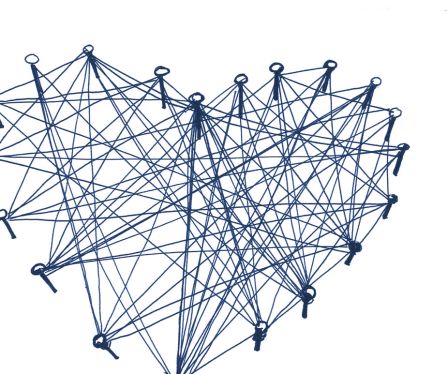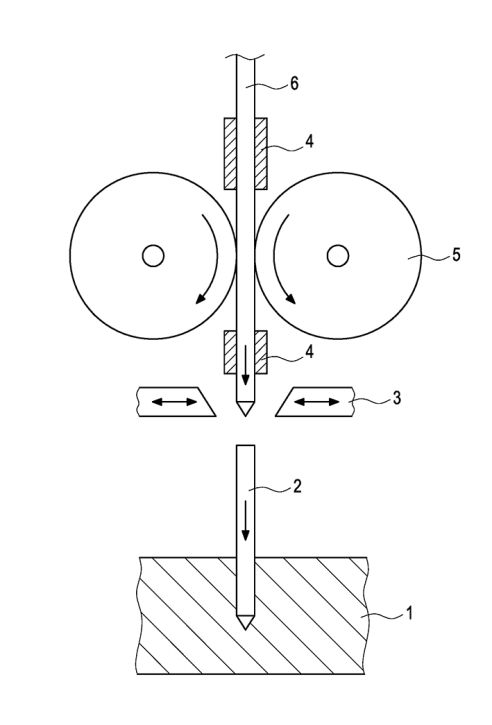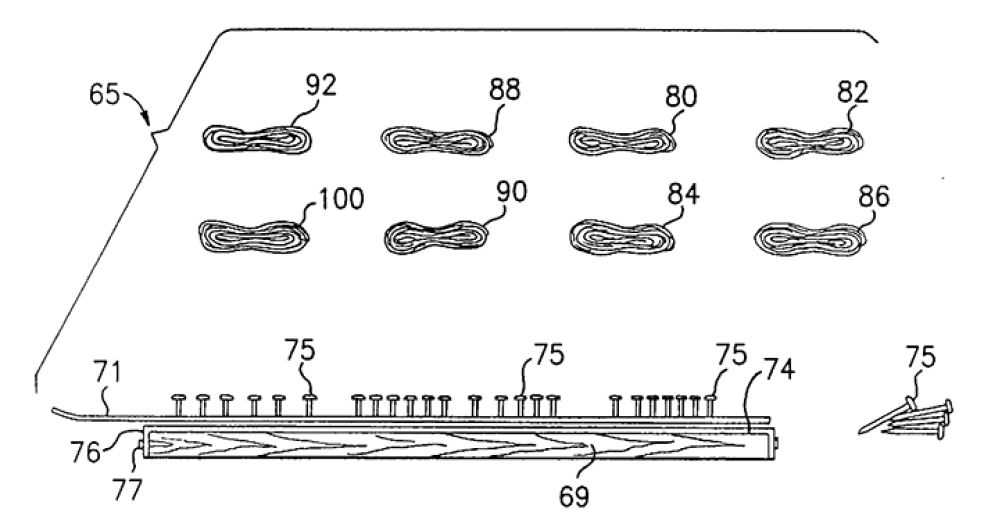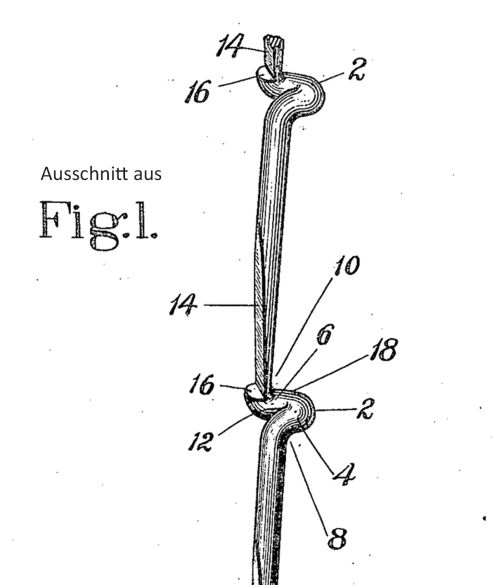
In season 11, episode 3, of the TV show "Die Höhle der Löwen" (German version of the US show Shark Tank and the UK show Dragon's Den), a young startup, WireStyle from Karlsruhe, Germany, presents photos in string art, so-called thread pictures. The WireStyle thread picture is a board (or plate) with a plurality of small nails around which a single long black thread is wrapped to create a picture. By superimposing the thread, the optical effect of a picture is created. For example, photos are created with thread on wood instead of ink on paper. Thread pictures are therefore a creative alternative to photo print. Wood type, wood color as well as thread color can be individualized as required.
An international patent application has been filed for the WireStyle thread picture, for which an international search report has been issued. By means of the WireStyle thread picture, it shall be shown how a claim wording can be interpreted in comparison to cited prior art, how the problem-solution approach is applied and how, by means of a little trick, the claim previously not regarded as novel over the prior art can even become inventive.
The international patent application – WO2022012916A2 (WO'916)
Subject-matter
Originally, it was attempted to protect the WireStyle thread picture in three independent claims: Claim 1, directed to the nail per se; Claim 4, directed to the plate with the nails; and Claim 6, directed to the method of manufacturing the plate with the nails (see reference signs in parentheses from Fig. 1 of WO'916).
Claim 1 of WO'916 defines the following features:
N1: A nail (2) for use in a string type representation,
N2: wherein the nail (2) has no thickening in the form of a head at an end.
Claim 4 of WO'916 defines the following features:
P1: A plate (1) as string type representation, comprising
P2: one or a plurality of nails (2), according to any one of the preceding claims.
Claim 6 of WO'916 defines the following features:
V1: A method of manufacturing a plate (1) according to any one of claims 4 or 5, comprising the steps of:
V2: Providing a continuous wire (6),
V3: Ramming the continuous wire (6) into the plate (1),
V4: Cutting the continuous wire (6) to length so as to result in a nail (2) according to any one of claims 1 to 3.

Prior Art
In the search report, the Search Division cites D1 (US4964774A), D2 (US6149436A), and D3 (US1440579A) as relevant to the subject-matter of the claims of WO'916. In particular, the Search Division considers claim 1 as not novel over D1, claim 4 as not novel over D2, and claim 6 as not inventive over a combination of D2 and D3.
Claim 1 – Lack of novelty over D1 (US4964774A)
D1 discloses in Fig. 1 of D1, as shown below, a nail 10 having one end (top side in Fig. 1 of D1) that is blunt and flattened, or has a larger diameter than the rest of the nail 10 and that is tapered towards the other end (bottom side in Fig. 1 of D1):
By its nature, the nail 10 of D1 is intended for various uses and thus fulfills characteristic N1.
Note: The terms "for use in a string type representation" is quasi-non-restrictive in claim 1, since any type of nail can be used for a string type representation, according to our understanding.
Also, the nail 10 has a tip at the lower end and thus does not have a thickening at "an" end in the form of a head according to the feature M2.
Thus, original claim 1 of WO'916 is not novel over D1.
Claim 4 – Lack of novelty over D2 (US6149436A)
D2 aims to provide a three-dimensional tactile art item (see columns 1 and 3 of D2, and Fig. 1 of D2 as shown below). Here, D2 discloses a kit 65 with wooden board 69 and thin paper sheet 71. Nails 75 are driven through paper sheet 71 into upper surface 74 of board 69.

Figure 1 from D2 – Drawing from US6149436A
The board 69 is thus a plate intended for a string type representation according to feature P1. Also, a plurality of nails 75 are driven into the board 69 according to feature P2, the lower end of which is pointed and thus has no thickening (see features P2 in connection with N1 and N2 from back-referenced claim 1; cf. nails 75 bottom right in Fig. 1 of D2).
Original claim 4 of WO'916 is therefore not novel over D2.
Note: Since claim 4 depends on any of claims 1 to 3, if the subject-matter of claim 1 were novel, the subject-matter of claim 4 would necessarily be novel.
Claim 6 – Lack of inventive step over D2 and D3 (US1440579A).
In the following, inventive step of the subject-matter of claim 6 is assessed using the problem-solution approach.
Note: The Problem-Solution Approach is the approach used by the European Patent Office to assess inventive step.
1) Closest prior art D2
Since D2 also describes a method of manufacturing a plate as described above with respect to claim 4, and D3 relates only to the manufacture of nails, D2 is the closest prior art, and discloses at least feature V1.
2) Distinguishing features compared to D2
Also, in D2, the nails are driven into the plate, similar to feature V3. However, D2 does not have an endless wire, but only individual nails driven into the plate.
Thus, claim 6 could be different from D2 by the following distinguishing features:
V2: Providing a continuous wire,
V3: Ramming the continuous wire into the plate,
V4: Cutting the continuous wire to length so as to result in a nail according to any one of claims 1 to 3.
Important: In method claims, such as the present claim 6, the execution order is usually interchangeable, so that in the present case feature V4 can be executed before features V2 and/or V3.
Accordingly, claim 6 differs from D2 only in the following distinguishing feature:
V2: Providing a continuous wire,
V3: Ramming the continuous wire into the plate,
V4: Cutting the continuous wire to length so as to result in a nail according to any one of claims 1 to 3.
Brief explanation: When the continuous wire is cut to length according to feature V4, this creates the nail, which is then provided according to feature V2 and then rammed into the plate according to feature V3. D2 shows the same principle in Fig. 1 (cf. column 3 in D2).
Thus, the difference of the subject-matter of claim 6 from D2 lies in feature V4.
3) Technical effect – objective technical problem
Feature V4 results in the technical effect of being able to produce individual nails. Consequently, the objective technical problem can be seen in providing the plurality of nails by the endless wire.
4) Obviousness
The skilled person could refer to D3 to solve the objective technical problem. D3 relates to the provision of a nail string. In order to facilitate the formation of points when the nails are separated from the nail string, the shanks are cut away at the heads 2 of the adjacent nails (see cut surface 14 in Fig. 1 of D3).
Since D3 concerns the provision of individual nails, a person skilled in the art would presumably combine the teachings of D2 and D3 in an obvious manner to solve the objective technical problem posed above. Thus, the skilled person would presumably not have to be inventive to arrive at the subject-matter of claim 6.

Figure 1 from D3 – Drawing from US1440579A
Effective delimitation option to D1, D2 and D3
A core idea of the WireStyle thread picture is to produce a plurality of headless nails from a continuous wire. Specifically, the head is omitted by first piercing the continuous wire into the surface of the plate and then cutting it to length (cf. page 2, lines 22 to 24, of WO'916). The headless shaping may result from the shape of the cutting device 3 (cf. Fig. 1 of WO'916 above).
In the cited prior art, on the other hand (cf. figures in D1, D2 and D3 above), the nails all have a head.
For example, claim 1 could be amended based on page 2, lines 17 and 18, of WO'916 so that the nail has "no thickenings in the form of heads". This would explicitly define both ends and distinguish them from D1 to D3, which each have nails with heads.
As a result, claim 4 would also differ from D1 to D3 due to the dependence of claim 1.
With respect to claim 6, alternatively, for example without such amendment to claim 1, or in addition to such amendment, feature V4 could be clarified by defining that it is performed after feature V3 (cf. for example, page 2, lines 22 to 24, of WO'916).
The nail without head or the corresponding cutting to length after ramming allows a faster and more efficient production of the string type representation compared to D1 through D3 (cf. page 2, lines 8 to 11, of WO'916).
As a result, due to a simple amendment to the wording of claim 1, for the entire set of claims, including claims 4 and 6, novelty and inventive step could be achieved. Therefore, a patent could be obtained for the WireStyle thread picture by means of this small amendment to claim 1 of WO'916 in later national/regional phases.
Note: The view presented herein is based only on the prior art cited in the search report. Should a nail without head according to the above-mentioned type already be known in the prior art, at least our view with regard to the indicated sequence of execution in method claim 6 would still apply.
Conclusion
It was shown how, when applying the problem-solution approach, a claim can be analyzed in view of the cited prior art with respect to inventive step. The boundaries between lack of novelty and lack of inventive step can often be vanishingly small. Thus, for the case of the WireStyle thread picture, it was shown that with a small clarification "headless" in device claim 1 or by changing the sequence of the method steps in method claim 6, a subject-matter that is not novel or not inventive compared to the cited prior art can become novel and inventive.
In view of the amendments proposed herein, the WireStyle thread picture could receive what we consider to be a very broad scope of protection, in which the nail, the plate and the method thereof could be protected side by side. Based on this scope of protection, potential competitors can be effectively deterred from imitating the innovative WireStyle thread picture in the future and, if necessary, displaced.
Author: Julian Graf
German and European Patent Attorney
Disclaimer: The above contribution reflects the personal opinion of the author. The assessments and statements made in the article do not constitute legal advice and are provided under exclusion of any liability. If you need an assessment of an individual case, please contact the author and/or the law firm KUHNEN & WACKER.


